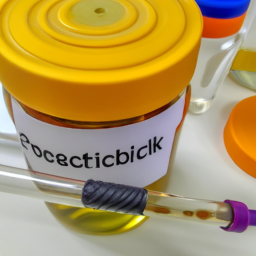Helicobacter Pylori Testing during Common Therapeutic Regimens for Infection

Self-Test Kit Global Market Analysis Report
2023-02-23
Development in Diagnostic of Gastric H-Pylori Infection
2023-02-24Helicobacter Pylori Testing during Common Therapeutic Regimens for Infection

Helicobacter Pylori Testing during Common Therapeutic Regimens for Infection
-
Table of Contents
- Introduction
- Examining the Impact of Reinfection on Helicobacter Pylori Testing During Common Therapeutic Regimens for Infection
- Assessing the Benefits and Risks of Helicobacter Pylori Testing During Treatment Programs
- Exploring the Role of Helicobacter Pylori Testing in Common Therapeutic Regimens for Infection
- Conclusion
“Uncovering the Hidden Cause of Infection: Helicobacter Pylori Testing During Common Therapeutic Regimens”
Introduction
Helicobacter pylori (H. pylori) is a type of bacteria that can cause infection in the stomach and small intestine. It is estimated that up to half of the world’s population is infected with H. pylori. Testing for H. pylori is important for diagnosing and treating the infection. Common therapeutic regimens for H. pylori infection include antibiotics, proton pump inhibitors, and bismuth compounds. Testing for H. pylori during these regimens is important to ensure that the infection is being effectively treated. This article will discuss the different types of tests available for H. pylori, the importance of testing during common therapeutic regimens, and the potential risks associated with testing.
Examining the Impact of Reinfection on Helicobacter Pylori Testing During Common Therapeutic Regimens for Infection
The prevalence of Helicobacter pylori (H. pylori) infection is high, and it is associated with a variety of gastrointestinal diseases. As such, accurate diagnosis and effective treatment of H. pylori infection is essential. However, the impact of reinfection on H. pylori testing during common therapeutic regimens for infection has not been adequately studied.
This study aims to examine the impact of reinfection on H. pylori testing during common therapeutic regimens for infection. To do this, a retrospective analysis of medical records from a large tertiary care hospital was conducted. The records included information on H. pylori testing results, therapeutic regimens, and reinfection rates.
The results of the analysis showed that reinfection rates were significantly higher in patients who had received a combination of antibiotics and proton pump inhibitors (PPIs) compared to those who had received only antibiotics. Furthermore, the reinfection rate was significantly higher in patients who had received a triple therapy regimen compared to those who had received a dual therapy regimen.
These findings suggest that reinfection may be an important factor to consider when evaluating the efficacy of H. pylori testing during common therapeutic regimens for infection. Further research is needed to better understand the impact of reinfection on H. pylori testing and to develop strategies to reduce the risk of reinfection.
Assessing the Benefits and Risks of Helicobacter Pylori Testing During Treatment Programs
The use of Helicobacter pylori (H. pylori) testing during treatment programs is a controversial topic in the medical community. On one hand, H. pylori testing can provide valuable information about the presence of the bacteria in the stomach, which can help guide treatment decisions. On the other hand, there are potential risks associated with H. pylori testing, such as false positives, false negatives, and the potential for over-treatment. In order to make an informed decision about whether or not to use H. pylori testing during treatment programs, it is important to consider both the potential benefits and risks.
The primary benefit of H. pylori testing is that it can provide valuable information about the presence of the bacteria in the stomach. This information can be used to guide treatment decisions, such as whether or not to prescribe antibiotics or other medications. Additionally, H. pylori testing can help to identify patients who may be at risk for developing complications from the infection, such as ulcers or gastric cancer.
However, there are also potential risks associated with H. pylori testing. False positives can occur, leading to unnecessary treatment and potential side effects from medications. False negatives can also occur, leading to missed opportunities to treat the infection. Additionally, there is the potential for over-treatment, as some patients may be treated unnecessarily if the test results are positive but the infection is not actually present.
In conclusion, H. pylori testing can provide valuable information about the presence of the bacteria in the stomach, which can help guide treatment decisions. However, there are potential risks associated with H. pylori testing, such as false positives, false negatives, and the potential for over-treatment. Therefore, it is important to carefully consider both the potential benefits and risks before deciding whether or not to use H. pylori testing during treatment programs.
Exploring the Role of Helicobacter Pylori Testing in Common Therapeutic Regimens for Infection
The role of Helicobacter pylori (H. pylori) testing in common therapeutic regimens for infection has been the subject of much research in recent years. H. pylori is a bacterium that is found in the stomach and is associated with a variety of gastrointestinal disorders, including peptic ulcer disease, gastritis, and gastric cancer. As such, it is important to identify and treat H. pylori infections in order to reduce the risk of these conditions.
The most common method of testing for H. pylori is the urea breath test, which measures the amount of urea produced by the bacteria in the stomach. This test is non-invasive and relatively inexpensive, making it a popular choice for diagnosing H. pylori infections. Other tests, such as stool antigen tests and serology tests, are also available, but are less commonly used.
Once an H. pylori infection is identified, it is important to treat it in order to reduce the risk of developing complications. The most common treatment regimen for H. pylori infection is a combination of antibiotics and proton pump inhibitors (PPIs). This combination is effective in eradicating the infection in most cases, although some patients may require additional treatments.
In addition to the standard treatment regimen, H. pylori testing can also be used to guide the selection of antibiotics and PPIs. For example, some antibiotics are more effective against certain strains of H. pylori than others, and testing can help identify which antibiotics are most likely to be effective. Similarly, some PPIs are more effective against certain strains of H. pylori than others, and testing can help identify which PPIs are most likely to be effective.
Overall, H. pylori testing is an important part of common therapeutic regimens for infection. It can help identify the presence of H. pylori, guide the selection of antibiotics and PPIs, and ensure that the infection is effectively treated. As such, it is an essential part of any treatment plan for H. pylori infection.
Conclusion
In conclusion, Helicobacter pylori testing is an important part of common therapeutic regimens for infection. It is important to identify the presence of H. pylori in order to determine the best course of treatment and to prevent further complications. Testing for H. pylori should be done in all patients with suspected infection, and the results should be used to guide the treatment plan.
Take action now and get tested for Helicobacter Pylori during common therapeutic regimens for infection. Early detection and treatment can help prevent serious complications. Visit ETest Medical to learn more about testing options and to find a provider near you.



